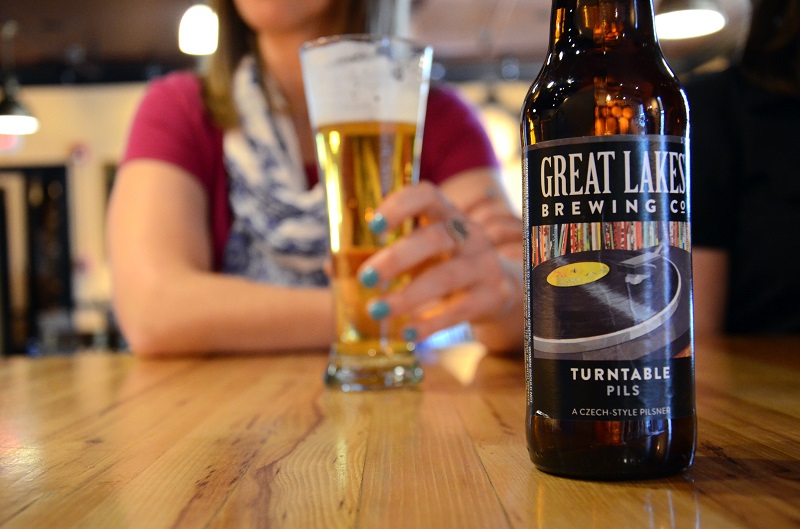Sponsored: The Rise (and the Return) of Craft Lagers

(Photo courtesy Great Lakes Brewing Co.)
Presented by Great Lakes Brewing Company
In 2015, craft lagers, and pilsners more specifically, were one of the fastest growing beer styles for small brewers. Historically, lagers dominated American beer sales. However, small American brewers are associated mostly with IPAs, pale ales, and now more exotic and intense styles such as sours and imperial stouts. In the past thirty years, many small American brewers were unsuccessful establishing themselves as lager breweries, and it’s rare for a U.S. craft brewery to experience long-term success solely brewing and selling lagers.
Craft lager pioneer Great Lakes Brewing Company is one of those rare breweries. The Cleveland, Ohio, brewery’s first beers, created more than 28 years ago, were lagers. Those flagship beers—Dortmunder Gold Lager and Eliot Ness Amber Lager—remain two of Great Lakes Brewing’s best-selling year-round offerings.
Brewmaster Mark Hunger has brewed at Great Lakes for almost 20 years. “For a long time, we were one of the only craft breweries that made lagers at a large production level,” he said. “Cleveland historically has been a lager-drinking town. That’s diversified now, but ‘Dort’ remains one of our best sellers and a hometown favorite.”

(Photo courtesy Great Lakes Brewing Co.)
When large numbers of Northern and Eastern Europeans immigrated to America in the 19th century, they brought their brewing techniques and favorite styles of beer with them. Many emigrants, who hailed from the birthplaces of lagers and pilsners, settled in or near Ohio. Thus, as Hunger notes, that area enjoys a long-standing love affair with lagers.
However, emigrant brewers faced the challenges of learning to brew with locally sourced ingredients, such as six-row barley, corn, and the more assertive American hops. Corn or maize often was added to lagers to smooth out the graininess from high levels of protein in the six-row barley, unique from the two-row barley more prevalent in European lagers. Although mass-produced, adjunct-heavy lagers now dominate the world’s beer market, U.S. craft brewers continue to redefine the style in America. Early American ingenuity cleared the way for today’s craft brewers to push boundaries, especially when it comes to giving lagers another chance.
“Over the past 20 years of craft beer growth, there’s been a tremendous focus on IPAs and pale ales,” Hunger notes. “But I think lagers are back to being the go-to beer for lots of beer drinkers. They’ve realized how flavorful and diverse these beers can be.”
Craft brewers often prefer making ales. Ales are fairly easy to manipulate during the brewing and fermentation process. They also ferment faster than lagers, thus freeing up valuable tank space and getting the liquid into beer lovers’ bellies more quickly. Producing ales can be a better business decision.
Ale yeasts and lager yeasts are entirely different species. While ale yeasts perform best at warmer temperatures, lager yeasts prefer the cold. The cold-loving lager yeast plus the longer conditioning time depresses the bulk of the fruity, estery flavors that can predominate in ales. This lagering process results in a clean, crisp beer that has nothing to hide behind—and which many brewers themselves love to imbibe.
“We have a proprietary yeast—our Great Lakes lager yeast—which is a lot of fun to work with,” Hunger said. “It’s a unique yeast. It’s very predictable. I often joke that you can set your watch by it. Once you’ve got experience making them, producing a really balanced lager is fairly easy from a production standpoint. Although they require more time and patience, they are less finicky than ales.”
Now we see many American craft breweries following in Great Lakes’ footsteps by embracing lagering. At the same time, beer drinkers are learning that lagers can be full of flavor, subtlety and complexity. Great Lakes’ spring seasonal pilsner, Turntable Pils, offers an earthy, but refreshing take on the classic style, while Eliot Ness Amber Lager’s slightly sweet, smooth, malty character makes it a perfect year-round brew. The brewery’s vibrant Oktoberfest is consistently the brewery’s best-selling seasonal lager. Oktoberfest is a beloved lager style that continues to gain traction in this country.
Luckily for beer aficionados, more and more craft brewers are turning to cold fermentation to produce beers that they, personally, love to drink regularly.
Anne Fitten Glenn writes mostly about beer, business and food. She’s the author of “Asheville Beer: An Intoxicating History of Mountain Brewing,” and she’s been published in numerous media outlets.

Leave a Reply